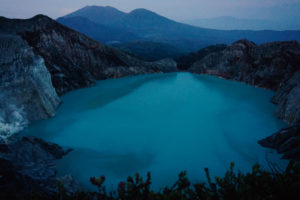Ijen Blue Fire Time
Blue Flames and a Blue Acid Lake
Kawah Ijen Volcano, on the island of Java, Indonesia has two of the most unusual occurrences on Earth. The first is an active solfatara that emits hot, flammable sulfurous gases. These ignite as they enter Earth’s oxygen-rich atmosphere and burn with an electric blue flame. Some of the gas condenses in the atmosphere to produce flows of molten sulfur that also burn with an electric blue flame. The flames are difficult to see during the day but illuminate the landscape at night which is determine the time for you to hike the mountain.
The second occurrence is a one-kilometer-wide caldera lake filled with turquoise-blue water. The color of the water is a result of its extreme acidity and a high concentration of dissolved metals by the bacteria. It is the world’s largest highly acidic lake with a measured pH as low as 0.5. The cause of its acidity is an inflow of hydrothermal waters charged with gases from a hot magma chamber below.
Sulfur Deposits
A continuous stream of sulfur-laden gases blasts from fumaroles at the lake-side solfatara. These hot gases travel underground in the absence of oxygen. If they are hot enough when they emerge from a vent, the sulfur ignites upon contact with oxygen in the atmosphere. Often the temperature is low enough that the sulfur condenses, falls to the ground as a liquid, flows a short distance, and solidifies. This produces a renewable deposit of mineral sulfur that local people mine and carry to a local sugar refinery that buys it.
Sulfur Mining
Miners walk up the flank of the mountain and then descend dangerous rocky paths down the steep walls of the caldera. Then, using steel bars, they break sulfur from an outcrop, load their baskets, and make the return trip to the refinery. Miners make one or two trips per day carrying up to 200 pounds of sulfur. The refinery pays them based upon the weight of sulfur that they deliver. The rate of pay amounts to a few dollars per trip. Ambitious and physically fit miners can make two trips per day.
Miners have carried hundreds of sections of pipe up the mountain. These have been used to capture the gases produced by numerous vents and route them to a single area where their sulfur spills onto a level work area. This makes collection more efficient and safer for the miners.
Sulfur mining at Kawah Ijen has its hazards. The steep paths are dangerous, the sulfur gases are poisonous, and occasional gas releases or phreatic eruptions have killed many miners.
Kawah Ijen Volcano is one of the few locations on Earth where sulfur is still produced by artisanal miners. Today, most of the world’s sulfur is produced as a byproduct of oil refining and natural gas processing. Nearly 70 thousand metric tonnes of sulfur are produced by these methods. A coincidence of low wages and a small local demand for native sulfur supports artisanal mining at Kawah Ijen.
Copyrights : Bali Java HOLIDAYS
Email : balijavaholidays@gmail.com
WA/Call :+6287755516005

